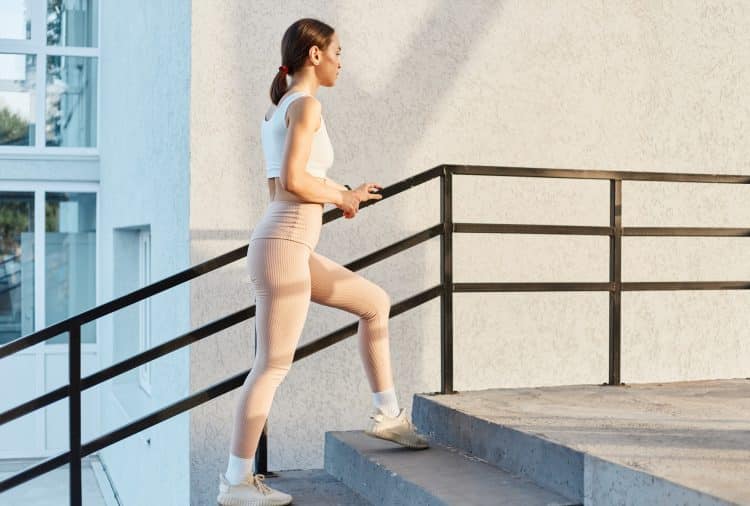Have you ever driven 15 minutes or less to the gym, only to tread on a Stairmaster or exercise bike for half an hour or more? It’s a little ironic, don’t you think? Yet, it underscores the fact that we have (literally) driven walking out of our lives.
The truth is we were born to walk. It’s our default form of cardiovascular exercise. We don’t need any equipment to do it; it’s accessible to most, and it’s free. So, don’t you think you should be doing more of it?
As a personal trainer, I’ve observed many people dismiss walking as an exercise because they think it’s too basic. They’ve been indoctrinated to believe you need a gym membership, fancy shoes, and a fitness app to get fit.
Yet, over the decades, I’ve built walking into the workouts of everyone from competitive bodybuilders determined to get ultra-ripped for a contest to 75-year-old women trying to lower their blood pressure and heart rate. Walking has helped my clients get to their fitness goals faster.
In this article, I’ll present the case for walking as an effective form of exercise. I’ll then lay out a dozen walking workouts to add variety to your walking routine, along with some handy personal trainer tips to maximize your walking gains safely and effectively.
Why Walk For Exercise?
Level Up Your Fitness: Join our 💪 strong community in Fitness Volt Newsletter. Get daily inspiration, expert-backed workouts, nutrition tips, the latest in strength sports, and the support you need to reach your goals. Subscribe for free!
Thousands of years ago, Greek physician Hippocrates, regarded as the father of medicine, said that walking is the best form of exercise. In recent decades, science has confirmed the accuracy of this observation. Here are six reasons why walking is such an effective form of exercise:
Improved Cardiovascular Health
Walking improves your cardiovascular health significantly. Specifically, it can help:
- Lower your blood pressure
- Reduce your risk of heart disease and stroke
- Improve your cholesterol level
During a walking workout, you are pumping blood around your body in a relaxed manner. That blood circulates oxygen and nutrients to your muscle tissue, helping to reduce the risk of cardiovascular disease. Your blood pressure will lower, and there will be less strain on the heart when you engage in a regular walking workout.
Walking also strengthens the heart. As you walk, your heart rate increases, challenging your cardio system and leading to adaptations that make your heart a stronger muscle. Your blood vessels dilate, allowing more blood to flow. This reduces the resistance against which the heart is pumping, so there is less strain on the organ.
Walking regularly for exercise will also help reduce your LDL (bad) cholesterol. High levels of this type of cholesterol lead to a build-up of plaque in the arteries, increasing your risk of heart disease.
Reduced Cortisol Levels
One of the body’s natural reactions to stress is to increase cortisol levels. When you walk outdoors, however, your parasympathetic system kicks in, reducing cortisol levels. As a result, simply going for a walk will make you feel calmer.
At the same time, walking for exercise releases feel-good endorphins, further helping reduce stress levels.
Calorie Burn
Walking is a low-impact form of cardiovascular exercise, making it ideal for weight loss. Many heavy people struggle with higher-impact exercises like jogging or jumping rope because they stress their ankle, knee, and hip joints too much.
Walking at a relatively brisk pace of 3.5 miles per hour (6 kph) will burn around 325 calories for a 155-pound (70 kg) person. They can burn an extra hundred calories by increasing the speed to 4.5 mph. You will burn even more calories by choosing a walking route that includes uphill climbing. Find here how many calories do you burn walking?
Walking is especially beneficial to get rid of belly fat. In one study, obese women who walked for 50-70 minutes three times per week for 12 weeks lost an average of 1.5 percent of their body fat and 1.1 inches (2.8 cm) of waist circumference. (1)
Is walking better than running for weight loss? Find out here.
Muscle and Bone Strength
Walking helps increase muscle and bone strength. The weight-bearing nature of the exercise increases bone density, helping prevent osteoporosis and lessening the likelihood of a fracture if you fall.
Less Likely to Die
People who walk regularly for exercise have been shown to have lower death risks from all causes. A 2019 study conducted by Jama Internal Medicine tracked the walking activity of 16,741 women over seven days. The study revealed that for older women, taking as few as 4,400 steps daily was significantly associated with reduced mortality rates from all causes. (2)
10 Walking Workouts
Walking doesn’t have to be boring, monotonous, or routine. Here are ten walking workout variations to keep things interesting:
1. Interval walking
Interval walking involves walking briskly for some time and then slowing down to a more moderate pace. This pattern is repeated at regular intervals throughout your walk.
A popular interval working plan I use with many of my senior personal training clients is to walk at a fast pace for two minutes and then reduce to a moderate pace for one minute. This fast/slow pattern continues for 30 minutes.
2. Hill Walking
Look for a route with hills. This will increase your calorie burn and challenge your quads, glutes, hamstrings, and calves. Start with gradual gradient hills and work up until you climb mini mountains.
3. Power Walking
Power walking involves maintaining a challenging pace throughout the workout. To do it, stand upright with your back straight, shoulders relaxed, and eyes straight ahead. Keep your core tight and your spine stable.
As you walk, swing your arms back and forth with your elbows bent at 90 degrees. Coordinate your arm and leg movements to help propel you forward. Your stride length should also be longer than your normal walking stride. Ensure that you’re landing heel to toe.
Level Up Your Fitness: Join our 💪 strong community in Fitness Volt Newsletter. Get daily inspiration, expert-backed workouts, nutrition tips, the latest in strength sports, and the support you need to reach your goals. Subscribe for free!
While you should be moving briskly, your heart rate shouldn’t be so high that you can’t sustain it without losing your breath. You should still be able to carry out a conversation, though with some difficulty.
Breathe deeply and rhythmically as you power walk. Inhale through your nose and exhale through your mouth.
Begin with a 15-minute power walk on flat terrain, then gradually increase your time weekly.
4. Stair Walking
Stair walking adds an extra element of challenge to your walking workout. Locate a staircase that will take you at least a few minutes to climb. Be sure to warm up first by marching in place, doing bodyweight squats and leg swings.
Walk up the stairs at a comfortable pace, looking at the step ahead of you so you don’t trip. Feel free to use the railing for support as needed. Plant your entire foot on each step, from heel to toe. This will promote stability and propulsion. Push through the balls of your feet to maximize upward thrust.
Be especially careful when coming down the stairs. Far more people suffer fall injuries when descending stairs than climbing them. To avoid being one of them, take small steps and hold onto the railing if you need extra support. Land softly on your feet to avoid joint impact.
5. Walking Lunges
A walking lunges workout adds lunges to your walking routine. The lunges are performed in a continuous forward-moving action. Be sure to warm up before this workout by doing lower-body dynamic stretching exercises such as body weight squats, hip circles, and glute kickbacks.
In the start position, stand tall with your feet shoulder-width apart and your hands on your hips. Now, take a large step forward, landing heel first. Lower into a lunge position to bring your rear knee close to the ground.
Push off with your front foot to return to the starting position, drive through your heel, and immediately step forward with your left foot to lunge the other leg.
I recommend incorporating lunges into your interval workout. Begin by doing 10 lunges on each leg and then walk at a moderate pace for one minute. Continue this pattern throughout a 15-20 minute workout.
6. Walking with Weights
Walking with weights involves adding resistance to your walking workout. You can hold hand weights, wear a weighted vest, or strap on a pair of ankle weights. This increases the workout intensity, boosting your calorie burn and strengthening your muscles.
Begin by using weights that feel relatively light, then gradually increase the resistance as you get fitter and stronger. Ensure that you stand tall, with your shoulders back and head up. Do not allow the fact that you’re holding weights cause you to slump forward as you walk.
Keep your core engaged as you walk to stabilize your spine and maintain proper posture. This can help improve your balance and stability, especially when carrying weights.
7. Walking Meditation
Walking meditation involves slowing down and focusing on your breath and the sensations of walking. Enjoy the natural beauty around you and use meditative breathing practices to help you clear your mind off daily distractions and enjoy the moment.
8. Speed Walking
Speed walking is when you are walking to achieve or beat a certain time. You’ll establish a specific walking distance and aim to finish it as soon as possible. Your walking form will be very similar to power walking.
Proper walking form is important when speed walking. Do not let your walk turn into a jog. Be mindful of traffic, obstacles, and uneven surfaces. Choose well-lit paths and wear reflective clothing if walking in low-light conditions.
9. Beach Walking
Beach walking offers a stunning ocean environment that will invigorate your senses. Walking on sand also provides a new level of challenge. The constantly shifting grains of sand create an unstable walking environment that demands more effort to maintain stability and balance.
With each step, your feet sink into the sand, requiring greater muscular effort to push off and propel yourself forward than walking on a solid surface. Walking on sand engages additional muscles in your feet, ankles, and lower legs to stabilize and navigate the uneven terrain.
This increased muscle activation provides a more comprehensive lower body workout compared to walking on flat ground.
Due to sand’s resistance and instability, walking on sand requires more energy than walking on solid ground at the same speed and distance. This can result in a higher calorie burn and increased cardiovascular workload.
Choose a beach with a wide, sandy shoreline free of rocks or steep terrain.
10. Group Walking
Grab a friend or join a walking group for social interaction and motivation. Walking with others can make the workout more enjoyable and help you stay accountable.
Wrap Up
Walking is an underestimated form of exercise that remains one of the most accessible ways to boost our health and fitness. I highly recommend adding several walking workout sessions to your weekly routine if you’re not already doing so.
Rotate through the 10 walking workouts presented here, then rinse and repeat. Progressively increase the duration and intensity of your walking workout, and you’ll be rewarded with a fitter, leaner, and more energetic body.
References
- Hong HR, Jeong JO, Kong JY, Lee SH, Yang SH, Ha CD, Kang HS. Effect of walking exercise on abdominal fat, insulin resistance and serum cytokines in obese women. J Exerc Nutrition Biochem. 2014 Sep;18(3):277-85. doi: 10.5717/jenb.2014.18.3.277. Epub 2014 Sep 10. PMID: 25566464; PMCID: PMC4241903.
- Lee IM, Shiroma EJ, Kamada M, Bassett DR, Matthews CE, Buring JE. Association of Step Volume and Intensity With All-Cause Mortality in Older Women. JAMA Intern Med. 2019 Aug 1;179(8):1105-1112. doi: 10.1001/jamainternmed.2019.0899. PMID: 31141585; PMCID: PMC6547157.
Article Updates Timeline:
Our editorial team experts constantly update the articles with new information & research, ensuring you always have access to the latest and most reliable information.
February 17, 2024
Written By
Steve Theunissen, PT
Edited By
Vidur Saini
Reviewed By
Editorial Team












